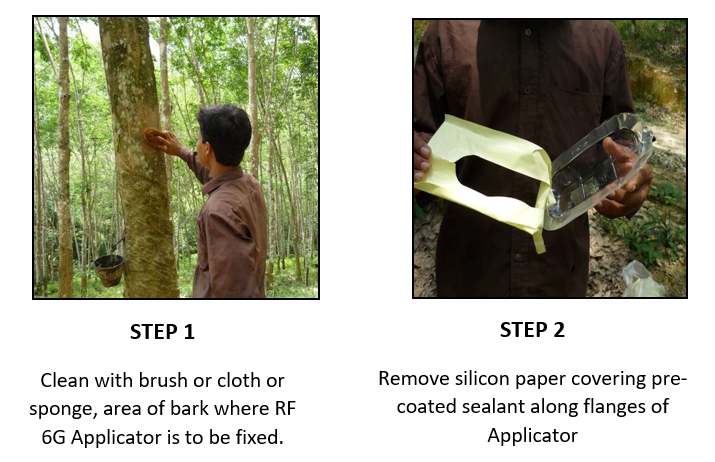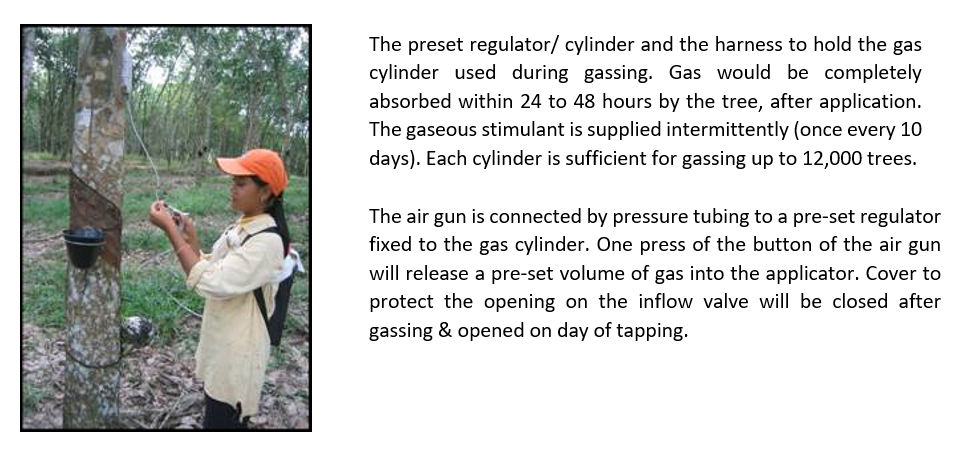PROCEDURES AND GUIDELINES FOR ADOPTION OF RRIMFLOW SYSTEM OF EXPLOITATION BY RUBBER SMALLHOLDERS
The RRIMFLOW System of Exploitation (RF 6G) is a most suited and well-established technology that can be adopted by rubber smallholders to achieve good yield productivity and earn high incomes from their holdings.
The RF 6G System involves tapping of short cuts (1/8s or 1/4s) (approximately 10.2 cm – 20.4 cm length) on d/3 or d/4 frequencies in combination with gaseous stimulation once in 10 days.
TREES SUITABLE FOR RF 6G ADOPTION
1. Trees above 20 years of age from planting and which have completed 15 years of tapping on basal virgin and renewed panels.
2. Trees which have not been tapped on high panels previously or only have been tapped for limited periods but with adequate bark reserves still available on high panels.
3. Trees not affected with any serious leaf or panel diseases.
DETAILS OF EQUIPMENT USED WITH RF 6G SYSTEM
DESCRIPTION OF EQUIPMENT USED WITH RF 6G SYSTEM
1. RF 6G Applicator – pre-coated with sealant in the factory and covered with silicon paper. Method of installation of Applicator on panel of rubber tree illustrated in the next section.
2. PVC tubing – One end of which is attached to the molded outlet tube on the body of applicator and the other end to which one-way inflow value is attached.
3. Inflow / One-Way Valve – For infusion of gas from the cylinder into the applicator with no back flow due to presence of one-way flow diaphragm inside the valve.
4. Gas Cylinder – Contains RF gas. A pre-set gas regulator is attached to the head and ensures that with each press of the button on the air gun, only a fixed volume of gas is injected into the applicator.
5. Air Gun – A metal gun connected to the outlet value on the regulator through a fixed length of pressure tubing. The nozzle fits exactly into the opening on the inflow valve.
6. Spanner – To open and close the valve on top of the gas regulator fitted to the cylinder.
7. External Sealant – To be used 5 to 6 months after initial fixing to seal the edges of the flange of the applicator stapled to the bark to ensure that there is no leakage of gas from the applicator.
ILLUSTRATION ON METHOD OF FIXING RF 6G APPLICATOR ON THE PANEL
The method of fixing the Applicator with pre-coated sealant at the chosen site on the panel of the tree is very simple and straightforward. It will only involve four simple steps as illustrated below:


APPLICATION OF EXTERNAL SEALANT (E-SEALANT) AFTER 5 TO 6 MONTHS FROM DATE OF INITIAL FIXING OF RF 6G APPLICATOR

POSITIONING OF APPLICATOR IN RELATION TO TAPPING CUT ON PANELS (HO-1 TO HO-4) AND BASAL PANELS (BO-2 & BI-1)


DEMONSTRATION ON METHOD OF GAS APPLICATION

CHOICE OF TAPPING SYSTEM AND RECOMMENDED FREQUENCY OF GASSING
1. For trees tapped on basal panels [Basal second virgin Panel (BO-2) or basal renewed panel (BI-1)], the tapping system will be 1/4s cut (20.4cm length) (quarter-spiral cut) tapped once in 3 days (d/3) or once in 4 days (d/4).
2. For trees tapped on high panels [Panel HO-1, HO-2, HO-3 or HO-4] the tapping system will be 1/8s ↑ (10.2cm length) tapped once in 3 days (d/3) or once in 4 days (d/4).
3. The gassing frequency for trees tapped on d/3 frequency will be once in 10 days (gas-tap-tap-tap-gas-tap) and for trees tapped on d/4 frequency it will also be once in 10 days (gas-tap-tap-gas-tap).
4. The maximum number of gassings irrespective of frequency of tapping will be three gassings per month and 36 gassings per year.
5. The trees are best gassed between 24 to 48 hours before tapping.
6. During wintering when trees are refoliating and before leaves harden (dark green in colour) the frequency of gassing can be reduced to once in 14 days.
ILLUSTRATIONS OF YIELDS THAT CAN BE REALIZED USING THE RF 6G SYSTEM


ACTIONS TO TAKE IF YIELD PRODUCTIVITY IS NOT SATISFACTORY
1. If the yields in the latex cup is low or the latex flow time is restricted with no late dripping then it indicates that the applicators are leaking with most of the gas diffusing out of the applicator instead of penetrating into the bark tissues.
2. Simple tests in the field that can be carried out to confirm that leakage of applicators is the cause for low yields or reduced latex flow time:
- The most common method is to apply gentle physical pressure at the centre of the body of the applicator so that it collapses and then simultaneously seal the outlet tube on the body of the applicator with the finger. If the applicator does not expand back to it’s original shape but remains collapsed then it indicates that there is a leakage problem.
- The worker gassing the trees even without the above simple tests will know if applicators are leaking when slight bulge in the body of the applicator is not detected after application of the gas. Instructions must be given to the worker to mark these trees so that they can easily be identified for maintenance work only on the affected trees. This approach will save costs both in terms of labor and materials usage.
3. If any of the above indicates applicator leakage than it would be advisable to apply physical pressure along the flanges of the applicator so that the pre-coated external sealant grips the bark more firmly. In the event this does not solve the problem then apply external sealant at the edges of the flange of the applicator in contact with the bark on the affected trees pre-marked by the worker carrying out the gassing operation.
4. Prophylactic application of external sealant on all the trees is only to be carried out after five to six months from date of fixing of applicator.
SAFETY PRECAUTIONS FOR HANDLING GASSING EQUIPMENT
1. Follow safety regulations in handling RRIMFLOW gas; adjust regulator to less than 2 psi; make sure only a short pulse of gas is applied during each gassing.
2. Avoid smoking during gassing and keep gas cylinders away from fire and young children.
3. Exercise care when transporting cylinders from the store to field for gassing.
4. Store cylinders in properly and adequately ventilated rooms. DO NOT store in CLOSED environments with no windows, no exhaust fans and no proper ventilation.


